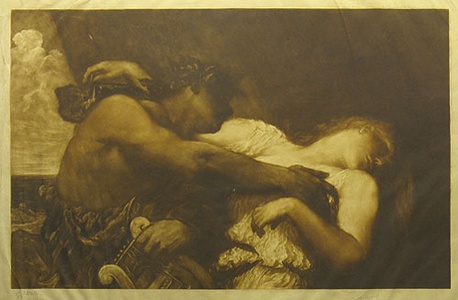| Method | Mezzotint |
| Artist | Sir Frank Short after George Frederick Watts |
| Published | London. Published Oct.r 1st 1889 by Rob.t Dunthorne at the Rembrandt Head, Vigo Street, W. |
| Dimensions | Image 310 x 495 mm, Plate 350 x 525 mm, Sheet 410 x 574 mm |
| Notes |
Signed in pencil by artist and engraver. Printed by Frederick Goulding. Proof printed on Japan paper: Edition 300. A dramatic scene showing Orpheus and Eurydice at the moment of Eurydice's death. Watts situates the pair within a cave like space, as waves and clouds swirl to the left. With his lyre in hand, Orpheus embraces Eurydice. Her head, slumped over his shoulder, indicates that she is already dead. The theme of Orpheus and Eurydice was popular amongst the Pre-Raphaelite Brotherhood, as well as the broader scope of Victorian artists. Lord Frederick Leighton, who would later reside closely to Watts in Kensington, exhibited a painting of the Grecian pair at the Royal Academy in 1864. Edward Burne-Jones also created illustrations for William Morris' poem of the subject. Though it was unpublished, the designs appeared in grey monochrome on the roundels of a piano that James Graham, a patron of Burne-Jones', commisioned for his daughter, Frances. Sir Frank Short (1857-1945) was born in Stourbridge, Worcestershire. He trained as an engineer but abandoned this career for art. He studied at South Kensington (later the Royal College of Art) and Westminster Schools of Art, London. He won gold medals at the Paris Salon for engraving and from 1891, until his retirement in 1924, he taught engraving at the Royal College of Art. The discipline he required from his students was largely responsible for the excellence of British etchings in the inter-war period. From 1910 to 1939 he was President of the Royal Society of Painter-Etchers, and in this capacity he was awarded a knighthood. In all, he produced some 209 etchings and drypoints and his subject matter included seascapes and foreshores from around Bosham and Rye in Sussex, the Mersey in the North West of England, Polperro and Seaford in Cornwall, as well as views in Holland. He worked directly from nature onto the plate which as the artist Martin Hardie observed makes demands upon the nerves and which gives the line a tremorous quality. His atmospheric nocturnes show something of his admiration for the work of James McNeil Whistler. George Frederic Watts (1817 – 1904) was a popular English Victorian painter and sculptor associated with the Symbolist and Pre-Raphaelite movements. Watts became famous in his lifetime for his allegorical works, such as Hope and Love and Life. These paintings were intended to form part of an epic symbolic cycle called the 'House of Life,' in which the emotions and aspirations of life would all be represented in a universal symbolic language. His large allegorical works on universal themes appealed deeply to the Victorians, and he was considered to be the greatest English artist of his age. Ex.Col.: Hon. Christopher Lennox-Boyd Condition: Light creases to sheet and image. Image evenly toned. |
| Framing | mounted |
| Price | £900.00 |
| Stock ID | 27909 |

